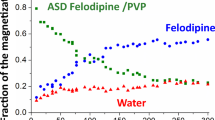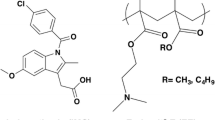Abstract
Purpose.
The purpose of the current study was to evaluate the molecular mobility of amorphous indomethacin and salicin in the relaxed glassy state based on spin-lattice relaxation times (T1c) and to clarify the effects of molecular mobility on their physical stability.
Methods.
Pulverized glassy amorphous indomethacin and salicin samples were completely relaxed, and the T1c values were investigated using solid-state 13C-nuclear magnetic resonance (NMR) at temperatures below the glass transition temperature (Tg). All NMR spectra were obtained using the T1c measurement method combined with variable-amplitude cross-polarization, the Torchia method, and total sideband suppression method.
Results.
The T1c value of amorphous indomethacin indicated that 73% of carbons were in a state of monodispersive relaxation, suggesting that the amorphous state was relatively homogeneous and restricted, particularly in backbone carbons. On the other hand, 92% of carbons of amorphous salicin exhibited both fast and slow biphasic relaxation. Individual structures of the salicin molecules behaved heterogeneously, and thus the entire molecule showed relatively fast local as well as slow mobility.
Conclusions.
At temperatures below Tg, amorphous salicin had relatively greater molecular mobility than amorphous indomethacin. This difference in the molecular mobility of the two compounds is correlated with their crystallization behavior. Solid-state 13C NMR provides valuable information on the physical stability of amorphous pharmaceuticals.
Similar content being viewed by others
References
1. L. Yu. Amorphous pharmaceutical solids: preparation, characterization and stabilization. Adv. Drug Deliv. Rev. 48:27–42 (2001).
2. M. Yoshioka, B. C. Hancock, and G. Zografi. Crystallization of indomethacin from the amorphous state below and above its glass transition temperature. J. Pharm. Sci. 83:1700–1705 (1994).
3. D. Zhou, G. G. Z. Zhang, D. Law, D. J. W. Grant, and E. A. Schmitt. Physical stability of amorphous pharmaceuticals: importance of configurational thermodynamic quantities and molecular mobility. J. Pharm. Sci. 91:1863–1872 (2002).
4. J. Liu, D. R. Rigsbee, C. Stotz, and M. J. Pikal. Dynamics of pharmaceutical amorphous solids: the study of enthalpy relaxation by isothermal microcalorimetry. J. Pharm. Sci. 91:1853–1862 (2002).
5. I. Weuts, D. Kempen, K. Six, J. Peeters, G. Verreck, M. Brewster, and G. V. Mooter. Evaluation of different calorimetric methods to determine the glass transition temperature and molecular mobility below Tg for amorphous drugs. Int. J. Pharm. 259:17–25 (2003).
6. S. L. Shamblin, B. C. Hancock, Y. Dupuis, and M. J. Pikal. Interpretation of relaxation time constants for amorphous pharmaceutical systems. J. Pharm. Sci. 89:417–427 (2000).
7. B. C. Hancock and S. L. Shamblin. Molecular mobility of amorphous pharmaceuticals determined using differential scanning calorimetry. Thermochim. Acta 380:95–107 (2001).
8. H. Sillescu. Heterogeneity at the glass transition: a review. J. Non-Cryst. Solids 243:81–108 (1999).
9. P. D. Martino, G. F. Palmieri, and S. Martelli. Molecular mobility of the paracetamol amorphous form. Chem. Pharm. Bull. 48:1105–1108 (2000).
10. B. C. Hancock, S. L. Shamblin, and G. Zografi. Molecular mobility of amorphous pharmaceutical solids below their glass transition temperatures. Pharm. Res. 12:799–806 (1995).
11. Y. Aso, S. Yoshioka, and S. Kojima. Explanation of the crystallization rate of amorphous nifedipine and phenobarbital from their molecular mobility as measured by 13C nuclear magnetic resonance relaxation time and the relaxation time obtained from the heating rate dependence of the glass transition temperature. J. Pharm. Sci. 90:798–806 (2001).
12. M. D. Ediger, C. A. Angell, and S. R. Nagel. Supercooled liquids and glasses. J. Phys. Chem. 100:13200–13212 (1996).
13. V. Andronis and G. Zografi. Crystal nucleation and growth of indomethacin polymorphs from the amorphous state. J. Non-Cryst. Solids 271:236–248 (2000).
14. K. J. Crowley and G. Zografi. The use of thermal methods for predicting glass-former fragility. Thermochim. Acta 380:79–93 (2001).
15. V. Andronis and G. Zografi. Molecular mobility of supercooled amorphous indomethacin, determined by dynamic mechanical analysis. Pharm. Res. 14:410–414 (1997).
16. Y. Aso, S. Yoshioka, and S. Kojima. Relationship between the crystallization rates of amorphous nifedipine, phenobarbital, and flopropione, and their molecular mobility as measured by their enthalpy relaxation and 1H NMR relaxation times. J. Pharm. Sci. 89:408–416 (2000).
17. E. Fukuoka, M. Makita, and S. Yamamura. Some physicochemical properties of glassy indomethacin. Chem. Pharm. Bull. 34:4314–4321 (1986).
18. E. Fukuoka, M. Makita, and S. Yamamura. Glassy state of pharmaceuticals. III. Thermal properties and stability of glassy pharmaceuticals and their binary glass systems. Chem. Pharm. Bull. 37:1047–1050 (1989).
19. A. Koga, E. Yonemochi, M. Machida, Y. Aso, H. Ushio, and K. Terada. Microscopic molecular mobility of amorphous AG-041R measured by solid-state 13C NMR. Int. J. Pharm. 275:73–83 (2004).
20. D. A. Torchia. The measurement of proton-enhanced carbon-13 T1 values by a method which suppresses artifacts. J. Magn. Reson. 30:613–616 (1978).
21. W. T. Dixon. Spinning-sideband-free NMR spectra. J. Magn. Reson. 44:220–223 (1981).
22. R. I. Shrager. Quadratic programming for nonlinear regression. Commun. ACM 15:41–45 (1972).
23. A. N. Garroway, W. B. Moniz, and H. A. Resing. High resolution 13C nuclear magnetic resonance in cured epoxy polymers. 13C N.M.R. in Polymers. Chem. Pharm. Bull. 13:63–74 (1979).
Author information
Authors and Affiliations
Corresponding author
Rights and permissions
About this article
Cite this article
Masuda, K., Tabata, S., Sakata, Y. et al. Comparison of Molecular Mobility in the Glassy State Between Amorphous Indomethacin and Salicin Based on Spin-Lattice Relaxation Times. Pharm Res 22, 797–805 (2005). https://doi.org/10.1007/s11095-005-2597-4
Received:
Accepted:
Published:
Issue Date:
DOI: https://doi.org/10.1007/s11095-005-2597-4




